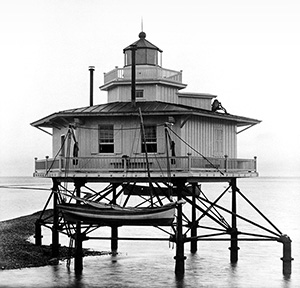History of Oysters in the Chesapeake Bay
 1.1 Link to Principles of Rebuilding
1.1 Link to Principles of Rebuilding
Oysters are quintessential examples of keystone species in coastal and estuarine waters from the subtropical through temperate latitudes worldwide. They are well represented in the fossil record and extant forms have been present for at least 50 million years with little morphological change. As sea level rises and falls over geological time frames oysters, with their prodigious fecundity and pelagic larval forms, are initial invaders of newly formed estuaries (ephemeral features in geological time, consider that the current Chesapeake Bay is only 10,000 years old). Notably, oysters create their own habitat on a large scale, a rare attribute among marine species as complex, three-dimensional oyster reefs. These reef structures serve several important physical, chemical and biological purposes. Physically, the reef structures prevent wind-driven fetch and thus mitigate sediment movement in estuaries. By reducing suspended sediment loads they increase light transmission through the water column and increase both water column and benthic photosynthesis. The implications for nutrient cycling and productivity at multiple trophic levels are obvious. Chemically the reefs form the single largest reservoir of alkalinity (buffering power) in the estuarine environment. Estuaries have been described as the “great titration” where acidic freshwaters meet buffered seawater. These regions of high productivity, driven by land-based nutrient supply, are nurseries for wider ranging migratory species (everything from fish to arguably many birds). These food chains are inevitably built on benthic marine invertebrates whose complex life histories include pelagic larval forms that settle and metamorphose on or in the benthos. These microscopic forms, typically less than a millimeter in maximum dimension, have little or no ability to osmoregulate and require a particular pH environment for their enzyme systems to function during and following the sensitive metamorphosis period. Oyster shells provide the essential carbonate buffering in the estuarine and coastal benthos to enable the development and perpetuation of these all-important diverse benthic communities.
Biologically, oysters are, through their filter feeding activity, agents of pelagic (water column) – benthic coupling. They facilitate the transfer of single-cell plankton productivity to benthic food chains that, in turn, support food webs all the way to apex predators such as migratory fishes. Finally, and rarely mentioned in the same context, oysters have, over anthropological time, been crucial to estuarine and coastal ecosystems that have been the centers of much human societal development. This ranges from native people who seasonally occupied “fishing camps”, the archeological record of the Chesapeake Bay is rich with such examples, to the coastal metropolises of the globe – simply examine a world map and note how many great cities are located on estuaries, locations that were originally chosen in part for their abundant supply of local seafood. So oysters, arguably as much as or more than any other animal form, have
The history of the Chesapeake Bay oyster resource has been well documented, from its seemingly limitless abundance in the days of early colonial settlement, through massive exploitation with product being shipped to both Europe by sea and the Pacific coast via the trans-continental railroad, to gradual victimization with environmental degradation, to the final insult of disease epizootics driven by a non native microorganism (MSX). By the mid-1970s the Chesapeake oyster resource was at an all-time low. Various estimates have placed its status at

